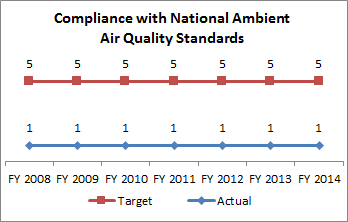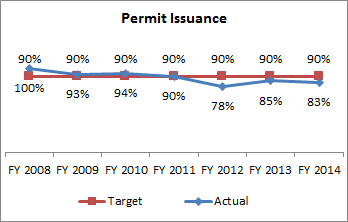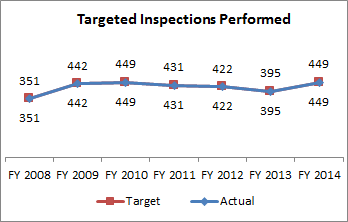The mission of the Division of Air Quality is to achieve and maintain levels of air quality that protect public health, property, and vegetation in Utah from the effects of air pollution. In order to accomplish its mission, this division is divided into the following three branches: (1) Compliance Branch, (2) Permitting Branch, and (3) Planning Branch.
During the 2015 General Session, the Legislature appropriated for Fiscal Year 2016, $14,944,900 from all sources for Air Quality. This is a 2 percent reduction from Fiscal Year 2015 revised estimated amounts from all sources. The total includes $5,626,700 from the General/Education Funds, a reduction of 19.7 percent from revised Fiscal Year 2015 estimates.
In addition to statewide compensation and internal service fund cost increases, the following appropriation adjustments were made during the 2015 General Session:
Compliance with Air Quality Standards
The number of air sheds in metropolitan statistical areas (MSAs) representing the state's population centers that meet all federal air quality standards annually. St. George, Provo-Orem, Salt Lake, Ogden-Clearfield, and Logan are the targeted MSA air sheds in the state. The EPA revised the standard for PM2.5 in 2006. Utah is developing a plan to bring four air sheds back into compliance by 2019.

Permit Issuance
UCA code 19-2-108 requires the director of the Division of Air Quality to issue permits with 180 days. However, the Governor's Balanced Scorecard goal was changed from 120 days to 110 days following a process improvement evaluation in 2011.

Compliance Inspections
Routine compliance inspections are targeted based on an annual compliance monitoring strategy (CMS). This measure ensures that scheduled inspections are performed as assigned.

Other Air Quality Performance Measures
In addition to the key performance measures listed above, the division reported the following performances measures for FY 2014:
- operated an ambient air monitoring network, providing pollution information for daily air quality status from 25 air monitoring locations;
- developed State Implementation Plans to bring three areas back into compliance with national ambient air quality standards; and,
- reviewed and issued air permits for 166 new or modifying sources.
A description of each section within the three branches within the Division of Air Quality follows:
Compliance Branch
- Major Source Compliance Section: This section is responsible for ensuring that the requirements of the Utah Air Conservation Act are met for all major sources. This is done by the inspection and enforcement activities of all major industrial air pollution sources located throughout the state. The division regulates around 100 major sources.
- Minor Source Compliance Section: This section is responsible for ensuring that the requirements of the Utah Air Conservation Act are met for all minor sources that have been issued an approval order. This is done by the inspection and enforcement activities of all of these sources located throughout the state. The division regulates over 1,800 minor sources through approval orders.
- Air Toxics, Lead-Based Paint, Asbestos, and Small Business Environmental Assistance Program Section (ATLAS): The ATLAS section's mission is to investigate and ensure compliance with the Utah Air Quality Rules. This is done through site inspections, asbestos and lead-based paint project notification reviews, and technical assistance to the public and the regulated community, and through enforcement actions.
- Major and Minor New Source Review Sections: The functions of these sections are mainly related to regulation of the emissions of air contaminants from "stationary sources" (industrial sources). This involves reviewing the design of all new or modified stationary sources to determine that the source will be able to comply with the Utah Administrative Code (UAC) and the Federal Air Quality Regulations. It is accomplished by issuing a construction permit called an Approval Order. To facilitate the workload, the New Source Review program is divided between the Major New Source Review and Minor New Source Review Sections.
- Operating Permit Section: The Federal Clean Air Act requires a program be developed in all states to issue renewable operating permits to specific large or major air pollution sources and provide special technical assistance.
- Air Monitoring Section: This section is responsible for the collection of accurate and precise ambient air data in Utah for use by local, state, and federal agencies.
- Technical Analysis Section: This section is responsible for a wide variety of tasks, including dispersion modeling, geographic information systems (GIS), and the collection and evaluation of emission inventories. The section also conducts special air quality studies for important state issues such as oil and gas development, Snake Valley aquifer pumping, and quality growth planning.
- Mobile Sources Section: This section is responsible for issues dealing with emissions from vehicles.
Recent air monitoring for ozone in the Uintah Basin has identified concerns with the levels measured during the winter months. The division led efforts to understand the chemistry and processes that result in elevated levels associated with oil and gas producing basins. In 2012, Duchesne and Uintah counties were accepted into EPA's Ozone Advance program. Work is underway with the counties and producers to proactively identify reasonable strategies to reduce the ozone levels. Monitoring stations were established in Roosevelt and Vernal to provide air quality forecasting and current conditions for public health notifications.
The DAQ-led 2013/14 multi-agency study to understand and improve wintertime ozone in the Uinta Basin continued, and valuable information was collected on emissions inventories and sources.
The Air Quality Board adopted a General Approval Order (GAO) rule (R307-401-19) that allows DAQ engineers to develop a single GAO for a category of similar types of smaller sources and would go through the normal public review process being issued.
DEQ launched an online Permit Wizard. This online tool will assist those individuals and companies involved in activities regulated by DAQ to identify the permits, licenses, registrations, and certifications required for those activities.
The Utah Air application for Android and Apple mobile devices was developed. This application provides users with pollutant levels throughout the state as well as advises users of air quality action alerts. To date, the application has been downloaded to over 15,000 devices.
COBI contains unaudited data as presented to the Legislature by state agencies at the time of publication. For audited financial data see the State of Utah's Comprehensive Annual Financial Reports.